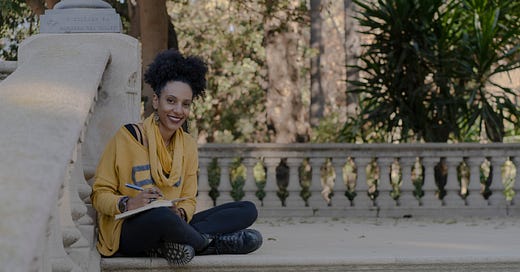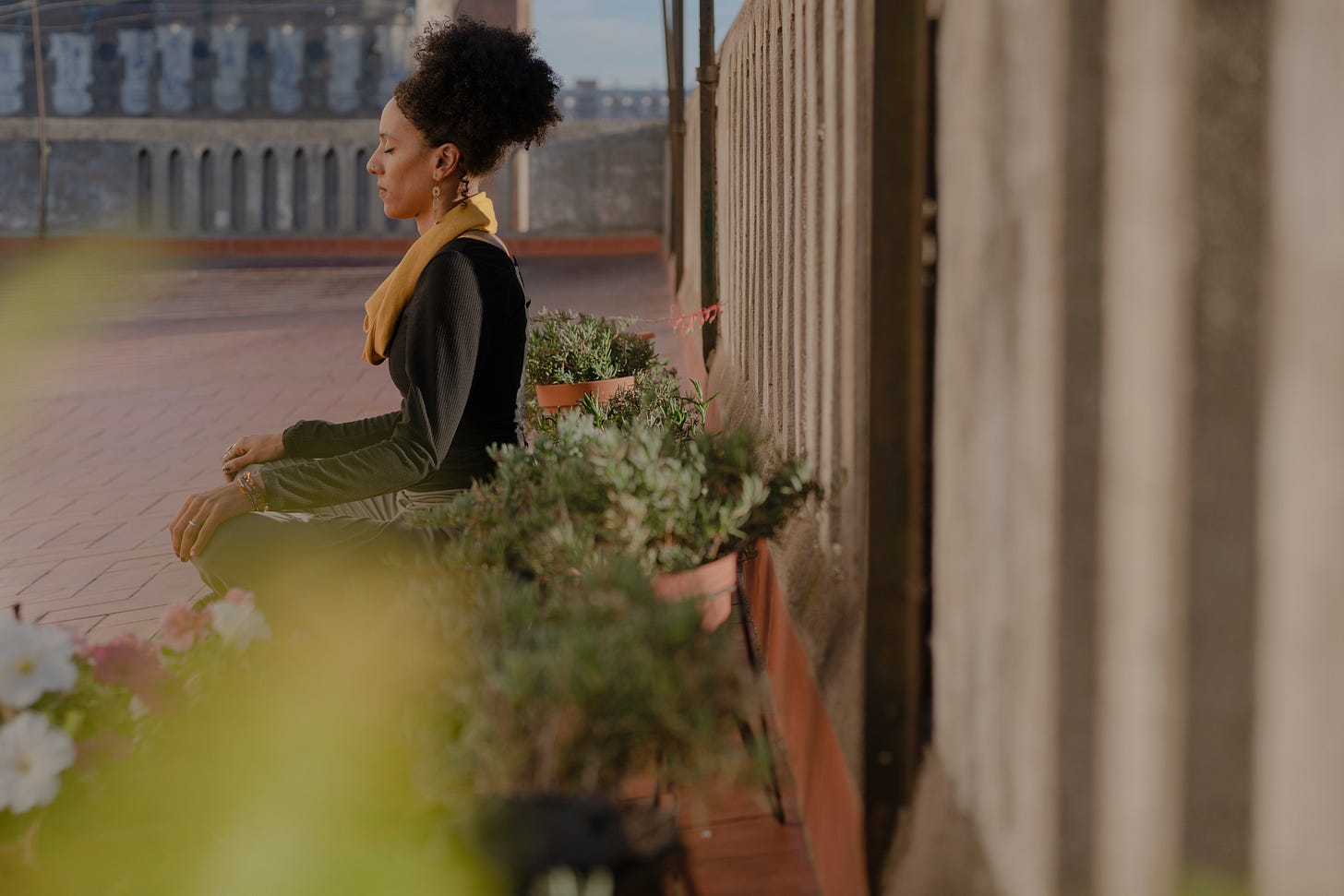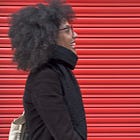No matter where I am in the world, my days begin with my journal open, hopefully by a sunny window with a view.
It’s funny because everything seems so clear, so attainable, written with my fancy fountain pen in blue ink.
Life goals, creative projects, and new beginnings. Intentions that become a lot more layered the moment I begin to live them.
Lately, I’ve been thinking about how routines, those carefully constructed rituals meant to bring stability and connect us to creativity, often get shaken up when life shifts.
I recently taught a workshop in Barcelona, Flourish and Create, where we discussed reasons why we get creatively blocked and why it’s hard to stick to habits that actually bring us joy. I wasn’t surprised to find that most of us struggle to stay consistent with anything that isn’t demanded of us, like work or caring for others.
Do you find that the practices that nourish you, ground you, and return you to the present moment are often the first ones to go when life gets full or things don’t go according to plan?
And yet, these are the very practices that tether us to our deeper rhythm.
A rhythm beyond what you can plot out in your calendar; a rhythm that allows you to inhabit the world more fluidly. The way your energy rises and falls with the light, or with the change of seasons.
I’ve started to think less about routines and more about rhythms. Rhythms ask you to listen.
They shift. They leave space.
They invite you back, again and again, without punishment.
Making Space for Flow
As a creative, I always felt like I needed to establish a rigid schedule to stay productive and accountable, yet with time, I have learned that doesn’t work for me. In fact, it stresses me out, and in the end, I am less focused and less productive.
I have learned that for me, it’s about paying attention to the rhythms that support my writing and creative work. Not rigid blocks of time or perfectly designed routines, but the quieter cues that tell me when to begin, when to pause, and when to go outside and let the words come to me later.
Over time, I’ve learned that creativity doesn’t thrive in chaos, but it also doesn’t thrive in overly rigid structure. It needs rhythm, space, and the kind of boundaries that hold, not confine.
So instead of forcing myself into a strict routine, I build my days around anchoring practices: small rituals that help me return to myself.
🌅Slow Mornings
If there is something I never skip is my slow morning ritual. I like to begin the day quietly, away from my phone, sitting with my journal and fountain pen. Listening to how the world and I rise.
Paying attention.

It flows as the seasons and my needs shift, but it always begins with Morning Pages.
Morning Pages are a stream-of-consciousness writing practice created by Julia Cameron where you empty your mind onto the page.
I don’t try to write anything profound; I just let whatever’s there move through me. Sometimes it’s messy. Sometimes it’s clear. But it always makes space for what’s next and allows me to see where I am starting from.
Once I am done with Morning Pages, I take a few minutes to move my body with a 10 to 15-minute yoga session, no need for more.
Try this one if you’d like:
🍉Fuel Comes First
One rhythm I’ve had to intentionally build — and protect — is eating regularly. As someone with Crohn’s disease and who gets easily immersed in creative work, I know I can’t create from an empty tank. My body needs healthy and steady fuel to stay grounded, and my mind works better when it isn’t running on adrenaline (and sometimes caffeine) alone.

So if there is one thing that I schedule in my day, it is meals.
Breakfast at 8, right after my Morning Pages, lunch at 15:00, berenar at 18:30, and dinner at 20:30. My meals are one of the only things in my daily calendar that are almost unmovable, and it also ensures that I take breaks and don’t end up burning myself out.
When I forget or skip meals, everything starts to feel foggy. I lose the thread. But when I take the time to cook and eat with presence, it becomes part of the creative rhythm, and I find my flow.
🧠Structuring Space to Create
Once I’ve finished my morning ritual and have fed myself, I shift into creative work. Luckily for me, I work on so many different projects that it is hard to get bored, but it also means it’s easy to get overwhelmed at times, or feel unsure of where to start.

I’ve found that a bit of gentle structure helps me stay anchored, without feeling boxed in.
Time blocking: carve out windows of time (usually 60 to 90 minutes) for focused work like novel or article writing, video editing, or audio recording. I try not to multitask. I leave space between blocks to reset. And I try to align certain kinds of work with times of day when my energy feels most suited to them.
Eisenhower matrix: a simple but powerful way of sorting tasks into what’s important vs. what isn’t. It helps me see clearly. It reminds me that just because something is loud doesn’t mean it matters and that quiet, steady things like rest, art, and community often belong in my calendar as much as “productive” ones.
You can stick to the traditional method, or adapt it to yourself, just like I do:


Traditional Eisenhower Matrix vs my version Pomodoro sprints: When I’m working for longer stretches, I use Pomodoro sprints — 25 minutes on, 5 minutes off, that’s the traditional way. But you can adapt it. Try 45 minutes on, 15 minutes off, or whatever matches your energy and the task at hand.
The Pomodoro method keeps me focused and from spiralling into perfectionism or exhaustion.
If you want to join my next live stream, find it here.
🧘🏾♀️Building in Breaks and Rest
One of the most radical things I’ve done for my creativity and my health is learning to take real breaks. Not scrolling breaks. Not "still doing something but telling myself I’m resting" breaks. Real ones.

I now treat rest as part of my workflow, not something I have to earn. That means building in longer pauses after lunch, giving myself full days off, and listening when my body says stop, even if the page is blank or the to-do list is full.
Breaks can be anything from naps, walks in nature, reading a book, listening to music, or birdgazing. The point is to let yourself relax and reset.
Returning to Rhythm
Our creative lives, like nature, move in cycles.
Some days are for deep work, some for stillness. Some seasons bring clarity, others bring steadiness, others bring turmoil. And the more you try to force a perfect routine onto that living, breathing rhythm, the more disconnected you become.
So now, instead of aiming for productivity at all costs, ask yourself:
How can I stay close to my rhythm today?
Sometimes that means creating, pushing yourself gently. Sometimes it means resting. Sometimes it means stepping outside to breathe, to listen, to come back to yourself before doing anything else.
And either way, trust that the rhythm, just like the ebb and flow of the ocean, will carry you back to shore.
Wherever you are in your path or your story, may you return to your rhythm again and again.
That’s all for now, my friend. 🍅
Until we meet again, pause often, breathe deeply, and be kind, especially to yourself.
Much love,
Laia
Loved this post? ⤵️
📲 Screenshot your favourite part and tag me @laia.bove
💌 Reply to this email—I’d love to hear from you!
☕ Buy me a Ko-Fi.
Or even…









Chile, I had to return to knowing the rhythm. It already lives in our bodies especially as women but since society doesn’t foster my type of rhythm I had to learn to create my own. I can’t work on the 24 hour routine, I need a 28 day routine. You know? As well as, I love a quiet morning sis! I love just free writing, very similar to what you are discussing. But it does feel good to know that others are in this space as well. They know their bodies and go about their days with intentions. Thanks for sharing!
This was so good and right on time. Taking intentional breaths helps me. I’m realizing I can go so many moments without deep breathing and when I do it calms my entire body.